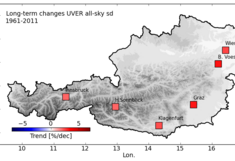UV-Radiation & Climate change
The reduction of ozone layer thickness in the stratosphere causes a rise of biologically relevant UV ground insolence. Significant influential factors for the transport of UV radiation through the atmosphere are cloudiness, aerosols and albedo. These factors can be severely influenced by the globally changing climate. According to the latest reports of the World Meteorological Organization (WMO) the ozone layer should be almost completely recovered until the middle of the 21st century. Reason for this positive development is the successful regulation of flourine, chlorine and bromine-rich substances (CFCs) in the Montreal Protocol and subsequent international treaties. The report clarifies the influence of climate change on the further development of the ozone layer, the pace of the ozone layer recovery will therefore show regional variations. Thus the intensity of UV ground insolation will still increase within the next years; higher melanoma incidence rates are to be expected. Hence changes in cloudiness responding to the change of global climate are of particular importance. Many regional climate scenarios show a significant reduction in cloudiness during the summer time in the Alpine region. Since increased melanoma incidence rates are already expected because of increased UV exposure at higher-altitude regions in Austria, the influence of climate change on UV radiation is especially relevant for Austria. If recreational behavior further increases exposure to solar light, a further increase of melanoma incidence rates can be expected. As seen in other countries, we know that educating the public in those matters can counteract this trend.

